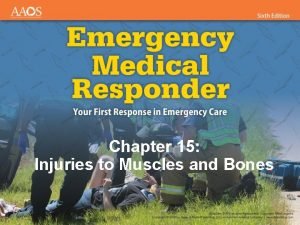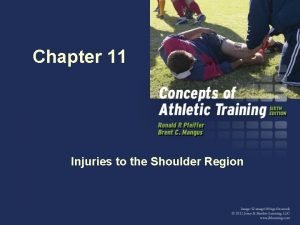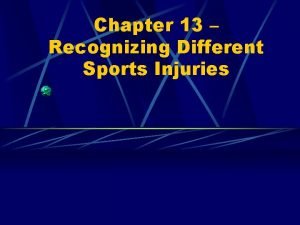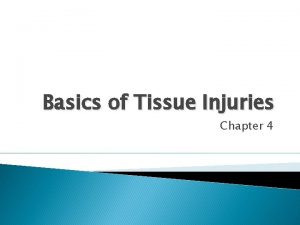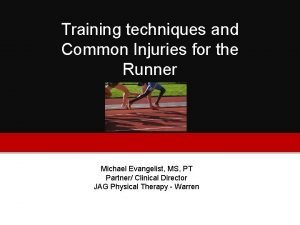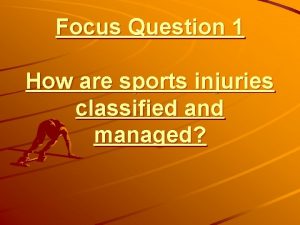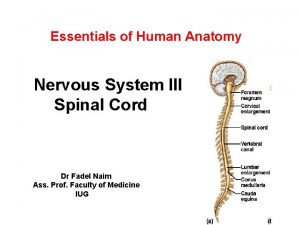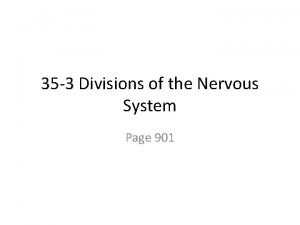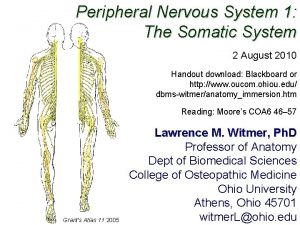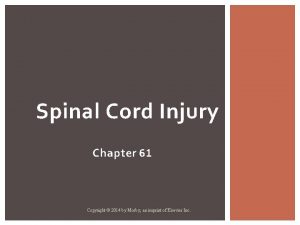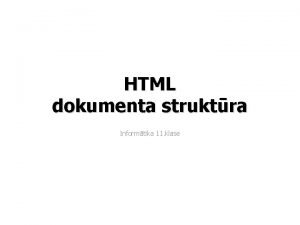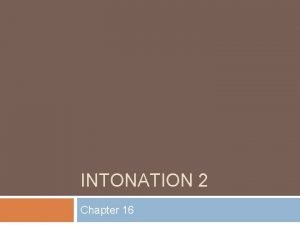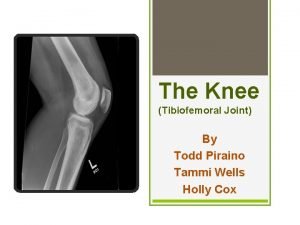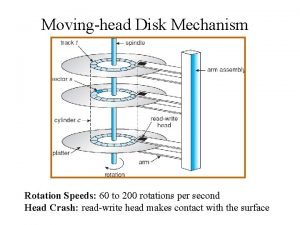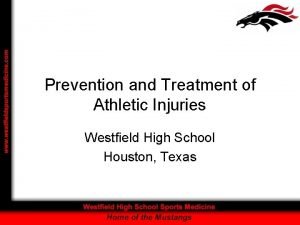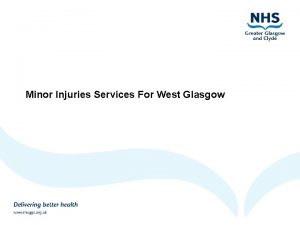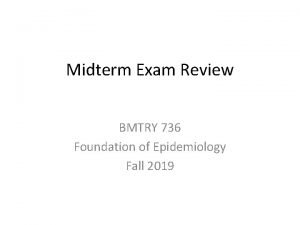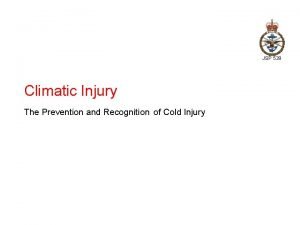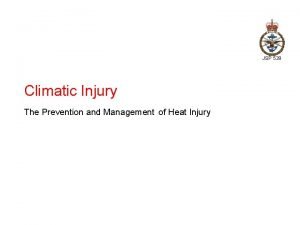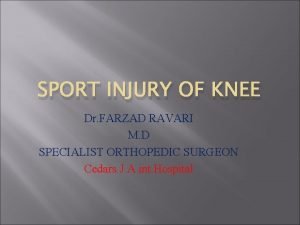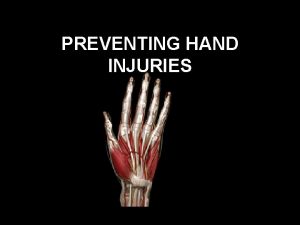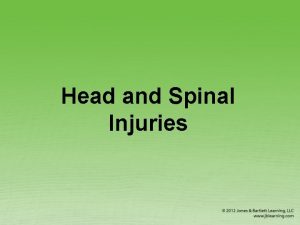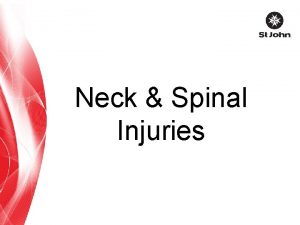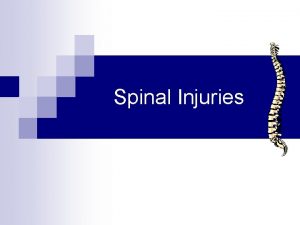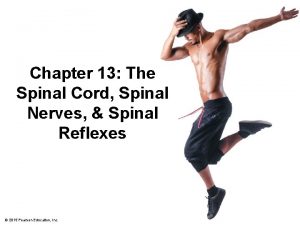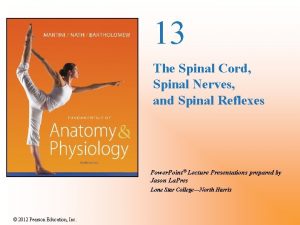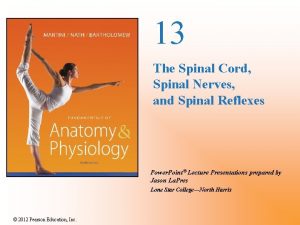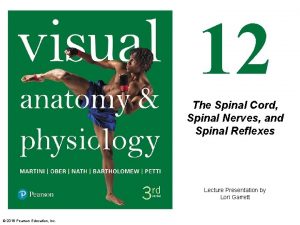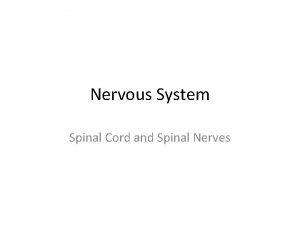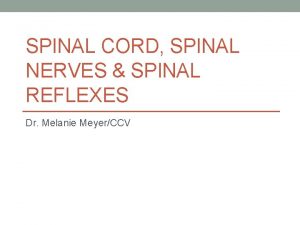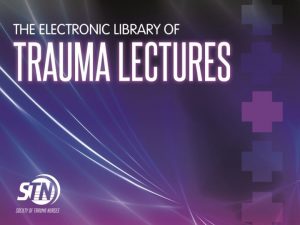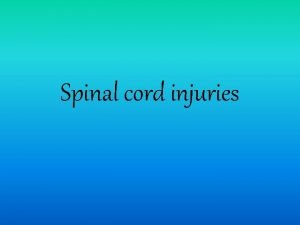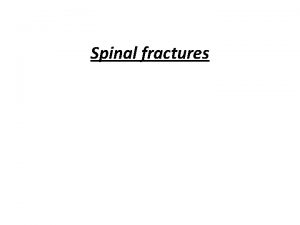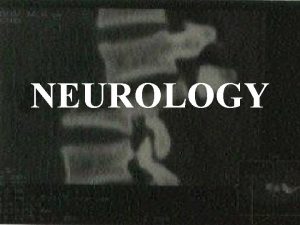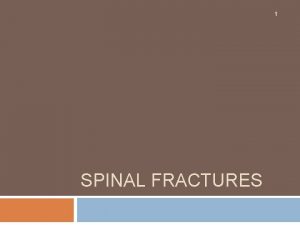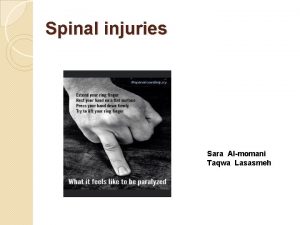Chapter 12 Head and Spinal Injuries Head Injuries




















































- Slides: 52

Chapter 12 Head and Spinal Injuries

Head Injuries • Scalp wounds • Skull fracture • Brain injuries

Scalp Wounds • Associated with heavy bleeding • The scalp has a rich blood supply. • The vessels do not constrict. • The brain obtains its blood supply from arteries in the neck.

Care for Scalp Wounds • Control bleeding by using direct pressure over wound. • If skull fracture is suspected, apply pressure around the edges of the wound. • Keep head and shoulders slightly elevated if spinal injury is not suspected. • Seek medical care.

Skull Fracture • A skull fracture is a break or crack in the cranium. • May be open or closed

Recognizing a Skull Fracture • • Pain at point of injury Deformity of the skull Bleeding from ears and nose Cerebrospinal fluid leaking from ear or nose Discoloration around eyes Discoloration behind ear Heavy scalp bleeding if the skin is broken Penetrating wound

Care for a Skull Fracture • Monitor breathing and provide appropriate care. • Stabilize the victim’s neck to prevent movement. • Elevate the victim’s head and shoulders to help control bleeding. • Cover the wounds with a sterile dressing. • Apply pressure around the edges of the wound.

Brain Injuries • When the head is struck with force, the brain bounces against the inside of the skull. • Swelling of brain tissue compresses the brain, which interferes with brain functioning. • Three types of commonly occurring brain injuries: • Concussion • Contusion • Hematoma

Recognizing Brain Injury (1 of 2) • Confused facial expression • Slow to answer questions or follow instructions • Easily distracted and unable to follow through with normal activities • Unaware of time, date, and place • Making disjointed statements • Stumbling, unable to walk a straight line

Recognizing Brain Injury (2 of 2) • Distraught • Asking a question that has already been answered or inability to memorize a series of three words • Coma, unresponsiveness

Care for Brain Injury (1 of 2) • Seek immediate medical care. • Suspect a spinal injury in an unresponsive victim until proven otherwise. • Stabilize the victim’s head and neck. • Monitor the victim’s breathing. • Control scalp bleeding with sterile dressings. • Roll the victim onto his or her side to help drain vomit.

Care for Brain Injury (2 of 2) • If spinal injury is not suspected, keep the victim in a slightly head-elevated position. • If victim is unresponsive, roll him or her onto the left side. • The victim’s level of responsiveness is one of the best indicators of neurologic function. • Using the mnemonic AVPU is especially helpful with small children.

Eye Injuries • • Penetrating eye injuries Blows to the eye Cut of the eye or lid Chemical in the eyes Eye avulsion Loose objects in the eye Light burns to the eye

Penetrating Eye Injuries • Penetrating eye injuries are severe injuries that result a sharp object penetrates the eye. • Suspect penetration any time you see a lid laceration or cut.

Care for Penetrating Eye Injuries • Seek immediate medical care. • Stabilize the object.

Blows to the Eye • Blows to the eye range in severity from minor or sight threatening. • A shiner or black eye occurs when some of the blood vessels around the eye rupture. • A blunt object can break the bone around the eyeball.

Care for Blows to the Eye • Apply ice for about 15 minutes. • Do not apply pressure on the eye. • Seek medical care if there is pain or reduced vision.

Cuts of the Eye or Lid • The signs of a cut eyeball or lid include the following: • Cut appearance of the cornea or sclera. • Inner liquid filling of the eye may come out through the wound. • Lid is cut.

Care for Cuts of the Eye or Lid • If eyeball is cut, do not apply pressure. • If eyelid is cut, apply gentle pressure. • Bandage both eyes lightly. • Seek medical care.

Chemical in the Eyes • Chemicals in the eyes can threaten sight. • Alkalis cause greater damage than acids because they penetrate deeper and continue to burn longer. • Damage can occur in 1 to 5 minutes.

Care for Chemical in the Eye • Hold the eye open. • Flush the eye with water for at least 20 minutes. • Loosely bandage both eyes with cold, wet dressings. • Seek medical care.

Eye Avulsion • A blow to the eye can avulse it (knock it out) from its socket. • This is a serious injury.

Care for Eye Avulsion • Cover the eye loosely. • Protect injured eye with a paper cup or doughnut-shaped pad. • Cover the undamaged eye with a patch. • Seek immediate medical care.

Loose Objects in the Eye • Loose objects in the eye are the most frequent eye injury and can be very painful. • Tearing is common because it is the body’s way of trying to remove the object.

Care for Loose Objects in the Eye • Lift the upper lid over the lower lid. • Try flushing the object out with water. • Examine the lower lid by pulling it down gently. • If you see the object, remove it with moistened sterile gauze.

Light Burns to the Eye • Burns can result if a person looks at a source of ultraviolet light such as sunlight, bright snow, or tanning lamps. • Severe pain occurs 1 to 6 hours after exposure.

Care for Light Burns to the Eye • Cover both eyes with cold, wet packs. • Tell the victim not to rub the eyes. • Have the victim rest in a darkened room. • Give pain medication, if needed. • Seek medical care.

Ear Injuries • Most ear problems are not life-threatening. • Except for disk batteries and live insects, few foreign bodies must be extracted immediately. • First aiders should seek medical care for the victim because attempts to remove a foreign body can rupture the eardrum or lacerate the ear canal.

Nose Injuries • Nosebleeds • Broken nose • Objects in the nose

Nosebleeds • Anterior nosebleeds • From front of nose • Most common, easier to care for • Posterior nosebleeds • From back of nose • More serious, require medical care

Care for Nosebleeds • Pinch the soft parts of the nose together. • Press firmly toward the face, for 5 to 10 minutes. • Keep the head higher than the heart. • Apply ice over nose. • Seek medical care if needed.

Recognizing a Broken Nose • Pain, swelling, and a possible crooked appearance. • Bleeding and difficulty breathing through nostrils • Black eyes appearing 1 to 2 days after injury.

Care for a Broken Nose • Seek medical care. • If bleeding is present, give care as for a nosebleed. • Apply an ice pack to the nose for 15 minutes. • Do not try to straighten a crooked nose.

Objects in the Nose • A foreign object in the nose is a problem mainly among small children.

Care for Objects in the Nose • Try to induce sneezing by having the victim sniff pepper. • Have the victim blow gently while you put compression on the opposite nostril. • Use tweezers to pull out an object that is visible. • Seek medical care if the object cannot be removed.

Dental Injuries • • • Objects caught between the teeth Bitten lip or tongue Loosened tooth Broken tooth Toothache

Objects Caught Between the Teeth • The main method of detecting a problem is if the victim says that something is caught between the teeth. • The object may or may not be seen.

Care for Objects Caught Between the Teeth • Try to remove the object with dental floss. • If unsuccessful, seek dental care.

Recognizing a Bitten Lip or Tongue • Signs of a bitten lip or tongue include: • Immediate pain when it happens • Blood may be seen

Care for a Bitten Lip or Tongue • Apply direct pressure with sterile gauze. • Apply ice or cold pack. • If bleeding does not stop, seek medical care.

Loosened Tooth • Trauma can cause teeth to become loosened in their sockets. • Applying pressure on either side of each tooth can determine looseness. • Any tooth movement indicates a possibly loose tooth.

Care for a Loosened Tooth • Have the victim bite down on a piece of gauze to keep the tooth in place. • Consult a dentist or an oral surgeon.

Knocked-out Tooth • A majority of the teeth knocked out each year in the United States could be saved with proper treatment. • Time is critical for successful reimplantation. • Steps must be taken to prevent the tooth from becoming dehydrated.

Care for a Knocked-Out Tooth • Have victim rinse mouth. • Place gauze in socket. • Find the tooth. • Keep tooth moist. • Take the victim and the tooth to a dentist.

Broken Tooth • The front teeth are frequently broken by falls or direct blows. • Such damage is not unusual in the victims of violent acts or motor vehicle crashes. • It is also common in children, especially those with an overbite.

Care for a Broken Tooth • Gently clean dirt and blood with a sterile gauze pad and water. • Apply an ice pack to the face to the area of the injury. • If you suspect a jaw fracture, stabilize the jaw. • Seek immediate dental care.

Toothache • The most common reason for toothaches is dental decay. • Victims frequently complain of pain limited to one area. • Pain can also affect the ear, eye, neck, or the opposite side of the jaw.

Recognizing a Toothache • The tooth will be sensitive to heat and cold. • Identify the diseased tooth by tapping the area with a spoon handle or similar object. • A diseased tooth will hurt.

Care for a Toothache • Rinse mouth with warm water. • Use dental floss to remove any food caught in teeth. • If you suspect a cavity, paint the tooth with clove oil to help suppress pain. • Give the victim pain medication if needed. • Seek dental care immediately.

Spinal Injuries • The spine is a column of vertebrae stacked on one another from the tailbone to the base of the skull. • The spinal cord consists of long tracts of nerves that join the brain with the other body organs. • If a broken vertebrae pinches spinal nerves, paralysis can result. • All unresponsive victims should be treated as though they have a spinal injury. • Suspect a spinal injury in all head-injury victims.

Recognizing Spinal Injuries • Painful movement or paralysis of arms and legs • Numbness, tingling, weakness, burning sensation in arms and legs • Loss of bladder or bowel control • Deformity of neck

Care for Spinal Injuries • Monitor breathing. • For an unresponsive victim, open the airway and check for breathing. • Stabilize the victim to prevent movement by using one of the following methods: • Grasp the victim’s head over the ears and hold the head and neck still until EMS arrives. • Kneel with the victim’s head between your knees or place objects on each side of the victim’s head to prevent it from rolling side to side.
 Spinal cord labelled
Spinal cord labelled Spine meninges
Spine meninges Median nerve innervates
Median nerve innervates Spinal cord structure
Spinal cord structure A short backboard or vest-style immobilization
A short backboard or vest-style immobilization Chapter 21 caring for head and spine injuries
Chapter 21 caring for head and spine injuries Chapter 15 injuries to muscles and bones
Chapter 15 injuries to muscles and bones Chapter 14:3 observing fire safety
Chapter 14:3 observing fire safety Chapter 14 bleeding shock and soft tissue injuries
Chapter 14 bleeding shock and soft tissue injuries Chapter 13:2 preventing accidents and injuries
Chapter 13:2 preventing accidents and injuries Chapter 11 assessment and evaluation of sports injuries
Chapter 11 assessment and evaluation of sports injuries Chapter 12 lesson 4 fitness safety and avoiding injuries
Chapter 12 lesson 4 fitness safety and avoiding injuries Test chapter 17 first aid
Test chapter 17 first aid Chapter 11 injuries to the shoulder region
Chapter 11 injuries to the shoulder region Chapter 4 preventing injuries through fitness
Chapter 4 preventing injuries through fitness Chapter 13 worksheet recognizing different sports injuries
Chapter 13 worksheet recognizing different sports injuries Chapter 4 basics of tissue injuries
Chapter 4 basics of tissue injuries Indexing head parts
Indexing head parts Suction lift
Suction lift Unit 15:3 providing first aid for bleeding and wounds
Unit 15:3 providing first aid for bleeding and wounds Common track injuries
Common track injuries How are sports injuries classified and managed
How are sports injuries classified and managed Foramen costo transversarium
Foramen costo transversarium Spinal meninges and associated structures
Spinal meninges and associated structures Spinal cord and brain
Spinal cord and brain Difference between epidural and spinal
Difference between epidural and spinal The skull spinal column ribs and sternum makeup
The skull spinal column ribs and sternum makeup Brain and spinal cord nervous system
Brain and spinal cord nervous system Somi brace
Somi brace Spinal cord dorsal and ventral roots
Spinal cord dorsal and ventral roots The attacking firm goes head-to-head with its competitor.
The attacking firm goes head-to-head with its competitor. Html tagi
Html tagi Moving head disk mechanism
Moving head disk mechanism Neck part of body
Neck part of body Tonic syllable
Tonic syllable Biceps femoris innervation
Biceps femoris innervation What is tone unit
What is tone unit The head of moving head disk with 100 tracks
The head of moving head disk with 100 tracks Yasuko namba
Yasuko namba Describe peeta's injuries
Describe peeta's injuries Sentinel injuries in infants are
Sentinel injuries in infants are Westfield sports injuries
Westfield sports injuries Glasgow minor injuries
Glasgow minor injuries Objective of a first aider
Objective of a first aider Tnt swimming
Tnt swimming Pallet jack injuries
Pallet jack injuries The cause-specific mortality rate from roller-skating was:
The cause-specific mortality rate from roller-skating was: Jsp539
Jsp539 Climatic injuries
Climatic injuries Bo taoshi injuries
Bo taoshi injuries Prepheral
Prepheral Preventing hand injuries
Preventing hand injuries Example of intentional injury
Example of intentional injury






